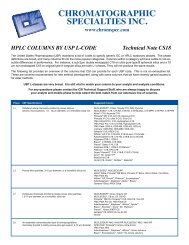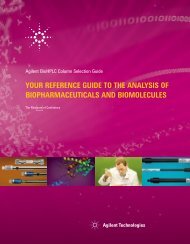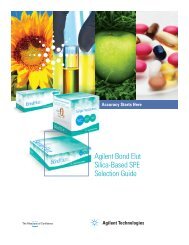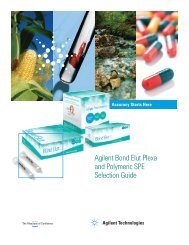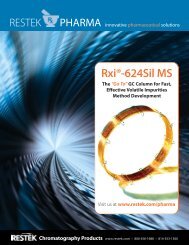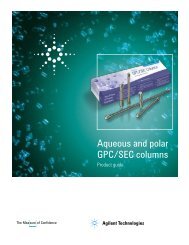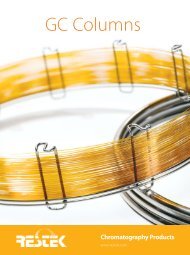Optimizing the Analysis of Volatile Organic Compounds
Optimizing the Analysis of Volatile Organic Compounds
Optimizing the Analysis of Volatile Organic Compounds
You also want an ePaper? Increase the reach of your titles
YUMPU automatically turns print PDFs into web optimized ePapers that Google loves.
Table II.<br />
Compositions and characteristics <strong>of</strong> common types <strong>of</strong> traps.<br />
Description Trap Designation Dry Purge Preheat (°C) Desorb (°C) Bake (°C)<br />
24cmTenax ® A yes 175 180 200<br />
15cm Tenax ® /8cm silica gel B no 175 180 200<br />
8cm Tenax ® /7.7cm silica gel/7.7cm charcoal C no 175 180 200<br />
16cm Tenax ® /7.7cm charcoal D yes 175 180 200<br />
1cm OV ® -1/7.7cm Tenax ® /7.7cm silica gel/ E no 175 180 200<br />
7.7cm charcoal<br />
1cm OV ® -1/15cm Tenax ® /7.7cm silica gel F no 175 180 200<br />
1cm OV ® -1/ 23cm Tenax ® G yes 245 250 260<br />
7.6cm Carbopack ® B/1.3cm Carbosieve ® S-III H yes 245 250 260<br />
8.5cm Carbopack ® C/10cm Carbopack ® B/ I (Vocarb 4000) yes 245 250 260<br />
6cm Carboxen ® 1000/1cm Carboxen ® 1001<br />
7.7cm Carbopack ® C/1.2cm Carbopack ® B J (BTEXTRAP ) yes 245 250 260<br />
10cm Carbopack ® B/6cm Carboxen ® 1000/ K (Vocarb 3000) yes 245 250 260<br />
1cm Carboxen ® 1001<br />
Moisture Control Systems—Water and Methanol Management<br />
Water and methanol can cause <strong>the</strong> biggest problems in purge and trap concentration. During<br />
<strong>the</strong> desorb step, water and methanol that accumulated on <strong>the</strong> trap are released into <strong>the</strong> chromatographic<br />
system. As much as 10µL <strong>of</strong> water can accumulate on a trap containing silica<br />
gel during a purge; this expands to 12mL <strong>of</strong> water vapor during desorption. 5 Interference<br />
caused by excess water is a problem during detection. For example, water vapor passing<br />
through a PID can cause a negative dip in <strong>the</strong> baseline. Water also can saturate a PID,<br />
decreasing its sensitivity and interfering with <strong>the</strong> identification <strong>of</strong> compounds that coelute<br />
with water. Detector saturation also can occur with MS systems. Although <strong>the</strong> lower end <strong>of</strong><br />
<strong>the</strong> scan range typically is adjusted above <strong>the</strong> molecular weight <strong>of</strong> water, interference can<br />
still occur. If <strong>the</strong> water plug is very large, <strong>the</strong> peaks for analytes that elute in <strong>the</strong><br />
water/methanol region will broaden and sensitivity will be reduced.<br />
In similar fashion, methanol also causes interferences with target analytes. The PID gives a<br />
positive signal for methanol as a broad, flat-topped peak that usually interferes with 2methylpentane,<br />
3-methylpentane, and vinyl chloride. Adjusting <strong>the</strong> MS scan range to start<br />
above 35amu can minimize <strong>the</strong> effects <strong>of</strong> methanol (mass/charge ratio <strong>of</strong> 31amu). When<br />
using an Rtx ® -VMS column, or a cyanopropylphenyl “624”-type column, methanol and<br />
chloroethane will elute simultaneously. This can affect sensitivity and linearity for<br />
chloroethane (Figure 9). When using a “502.2” phase column, methanol coelutes with bromomethane.<br />
Spiking higher concentration intermediate standards into <strong>the</strong> purge vessel or<br />
autosampler vials can minimize methanol interference. Also note that an increase in<br />
methanol added to <strong>the</strong> purge standard also inevitably increases <strong>the</strong> amount <strong>of</strong> water that<br />
purges into <strong>the</strong> system.<br />
In recent years, much work has gone into developing hydrophobic adsorbents that minimize<br />
water collection on <strong>the</strong> trap. Extensive studies recommend incorporating a dry purge cycle<br />
to remove water from <strong>the</strong> trap prior to desorption. Current designs <strong>of</strong> purge and trap systems<br />
have added features to eliminate water prior to delivering <strong>the</strong> sample to <strong>the</strong> chromatographic<br />
system. Moisture control systems (MCS) remove water by condensation, prior to <strong>the</strong> desorb<br />
step. Such systems typically are composed <strong>of</strong> a piece <strong>of</strong> metal tubing that is heated during<br />
purge and <strong>the</strong>n cooled to 30°C. The sample, desorbed from <strong>the</strong> heated trap, travels<br />
through <strong>the</strong> MCS, where a large portion <strong>of</strong> <strong>the</strong> water is condensed from <strong>the</strong> saturated carrier<br />
gas. These systems are very effective for GC methods that do not have polar/active compounds,<br />
such as ketones, in <strong>the</strong> analyte list. An older purge and trap system that does not<br />
have an MCS can be retr<strong>of</strong>itted with one. Restek <strong>of</strong>fers an MCS bypass line for Tekmar<br />
3000 and 3100 purge and trap concentrators, to increase response and maintain linearity for<br />
ketones, alcohols, and acetates (Figure 10, page 14). When analyzing samples for ketones or<br />
o<strong>the</strong>r polar compounds, <strong>the</strong> MCS should be bypassed to maintain linear calibration for <strong>the</strong>se<br />
compounds.<br />
5. OI Analytical, “OI Analytical Model 4560 Sample Concentrator Rapid Trap Heating”<br />
Application Note 04521297.<br />
13<br />
www.restekcorp.com





